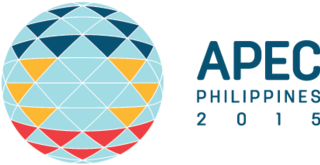 W
WThe economy of the Philippines is the world's 34th largest economy by nominal GDP according to the International Monetary Fund 2021 and the 12th largest economy in Asia, and the 3rd largest economy in the ASEAN after Indonesia and Thailand. The Philippines is one of the emerging markets, and the 3rd highest economy in Southeast Asia by nominal GDP nominal, following Thailand and Indonesia.
 W
WThe Anti-Money Laundering Council (AMLC) is the agency of the Government of the Philippines that is tasked to implement the provisions of Republic Act No. 9160, also known as the “Anti-Money Laundering Act of 2001” (AMLA), as amended, and Republic Act No. 10168, also known as the “Terrorism Financing Prevention and Suppression Act of 2012” (TFPSA).
 W
WAPEC Philippines 2015 was the year-long hosting of the Asia-Pacific Economic Cooperation (APEC) meetings which concluded with the APEC Economic Leaders' Meeting held on 18–19 November 2015 in Pasay, Metro Manila. It was the second time the Philippines hosted the summit, the first being in 1996.
 W
WThe ASEAN–China Free Trade Area (ACFTA) is a free-trade area among the ten member states of the Association of Southeast Asian Nations (ASEAN) and the People's Republic of China.
 W
WThe Bangko Sentral ng Pilipinas is the central bank of the Philippines. It was established on July 3, 1993, pursuant to the provision of Republic Act 7653 or the New Central Bank Act of 1993 as amended by Republic Act 11211 or the New Central Bank Act of 2019.
 W
WThe Brunei Darussalam–Indonesia–Malaysia–Philippines East ASEAN Growth Area (BIMP-EAGA) was launched in 1994 in Davao City, Philippines. It is located in one of the world's most resource-rich areas in Southeast Asia and includes the Heart of Borneo and the Sulu-Sulawesi Marine Ecoregion.
 W
WCoffee production in the Philippines began as early as 1740 when the Spanish introduced coffee in the islands. It was once a major industry in the Philippines, which 200 years ago was the fourth largest coffee producing nation.
 W
WThe Philippines has an exclusive economic zone that covers 2,263,816 square kilometers (874,064 sq mi) of sea. It claims an EEZ of 200 nautical miles (370 km) from its shores. This is due to the 7,641 islands comprising the Philippine archipelago. The total land area, including inland bodies of water, of the Philippines is 300,000 square kilometers (120,000 sq mi). It has the fifth longest coastline in the world with 36,289 kilometers (22,549 mi). The coordinates are between 116° 40', and 126° 34' E longitude and 4° 40' and 21° 10' N latitude. It is bordered by the Philippine Sea to the east and north, the South China Sea to the west, and the Celebes Sea to the south.
 W
WFilipino seamen, also referred to as Filipino seafarers or Filipino sailors, are seamen, sailors, or seafarers from the Philippines. Although, in general, the term "Filipino seamen" may include personnel from the Philippine Navy or the Philippine Marine Corps, it specifically refers to overseas Filipinos who are "sea-based migrant Filipino workers".
 W
WOne Town One Product (OTOP) is a promotional program of the government of the Philippines. OTOP aims to promote goods and products of Filipino towns, cities, and regions, and provides funding for small businesses. It is administered by the Department of Budget and Management (DBM).
 W
WOverseas Filipino Worker (OFW) is a term often used to refer to Filipino migrant workers, people with Filipino citizenship who reside in another country for a limited period of employment. There are over 10 million Filipinos working abroad, making the Philippines "one of the biggest export countries of labour".
 W
WAn overseas Filipino is a person of full or partial Filipino origin—i.e. people who trace back their ancestry to the Philippines but living or residing outside the country. This term generally applies to both people of Filipino ancestry and citizens abroad. As of 2019, there were over 12 million Filipinos overseas.
 W
WThe Philippine peso, also referred to by its Filipino name piso, is the official currency of the Philippines. It is subdivided into 100 centavos or sentimos in Filipino. As a former colony of the United States, the country used English on its currency, with the word "peso" appearing on notes and coinage until 1967. Since the adoption of the usage of the Filipino language on banknotes and coins, the term "piso" is now used.
 W
WThe Philippine Stock Exchange, Inc. is the national stock exchange of the Philippines. The exchange was created in 1992 from the merger of the Manila Stock Exchange and the Makati Stock Exchange. Including previous forms, the exchange has been in operation since 1927.
 W
WGoverning authorities in the Philippines have issued a variety of stamps for internal revenue taxes and other fiscal taxes since 1856. Prior to 1856, internal revenues were collected via stamped paper. Revenue stamps for the Philippines were issued by the Spanish East Indies government (1856–1898), the revolutionary government of the First Philippine Republic (1898–1901), the Insular Government of the United States (1901–1935), the government of the Commonwealth of the Philippines, the Philippine Executive Commission (1942–44) and the Republic of the Philippines (1946–present).
 W
WThe Tiger Cub Economies collectively refer to the economies of the developing countries of Indonesia, Malaysia, the Philippines, Thailand and Vietnam, the five dominant countries in Southeast Asia.